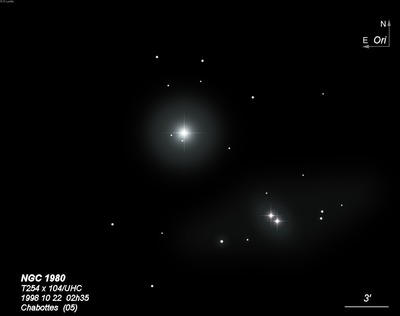Lower Sword
Lower Sword

William Herschel discovered NGC 1980 = H V-31 = h361 on 31 Jan 1786 (sweep 517) and noted "Iota Orionis seems with its neighbouring stars to be involved in milky nebulosity; but it is so faint and the number of stars makes the field so bright, that I cannot assure myself; though I compared this spot with the preceding and following ones." He observed it again on sweep 529 and recorded "Iota certainly affected, but no more that what the tinge of the bottom in this neighbourhood will account for." John Herschel noted on 8 Jan 1831 (sweep 218), "Iota Orionis involved in a feeble neb 3' diam."
Iota Orionis was first observed with Lord Rosse's 72" on 28 Jan 1849. Either Lord Rosse or assistant Johnstone Stoney recorded, "Dark space in the nebula containing nearest companion; light nearly equable; sketch made (by Stoney); 3-feet telescope employed. All the stars in the neighbourhood are nebulous, of these two a little sp, last seem to have dar spaces as in figure."
William Lassell made an observation on 7 Jan 1853 with his 24-inch equatorial reflector and reported, "Surveyed this star for some time without any impression of a nebula about it. At length I began to conceive that the glare around it, which I had attributed to the splendour of the star, might be really nebulous; and on further looking attentively at the stars, I could fancy they were on a black ground in the midst of the nebulae; but, without the suggestion of Lord Rosse's drawing, I think the appearance would have escaped me." Observing with the 48" Melbourne telescope on 3 Jan 1886, Pietro Baracchi commented, "Uncertain - Is it nebulosity or stray diffused light from the stars?"
It is very possible that WH observed just scattered light around Iota, since the very southern end of M42 has a very low surface brightness and would be difficult to distinguish among the several bright stars in the field. Wolfgang Steinicke favors interpreting NGC 1980 as an illusion (personal email on 21 Mar 2015), though Harold Corwin is not convinced (personal email of 23 Mar 2015).
300/350mm - 13.1" (1/28/84): very faint, large nebulosity of low surface brightness surrounding Iota Orionis (V = 2.8). Very difficult to distinguish from glare of Iota. M42 lies 30' N.
Notes by Steve Gottlieb